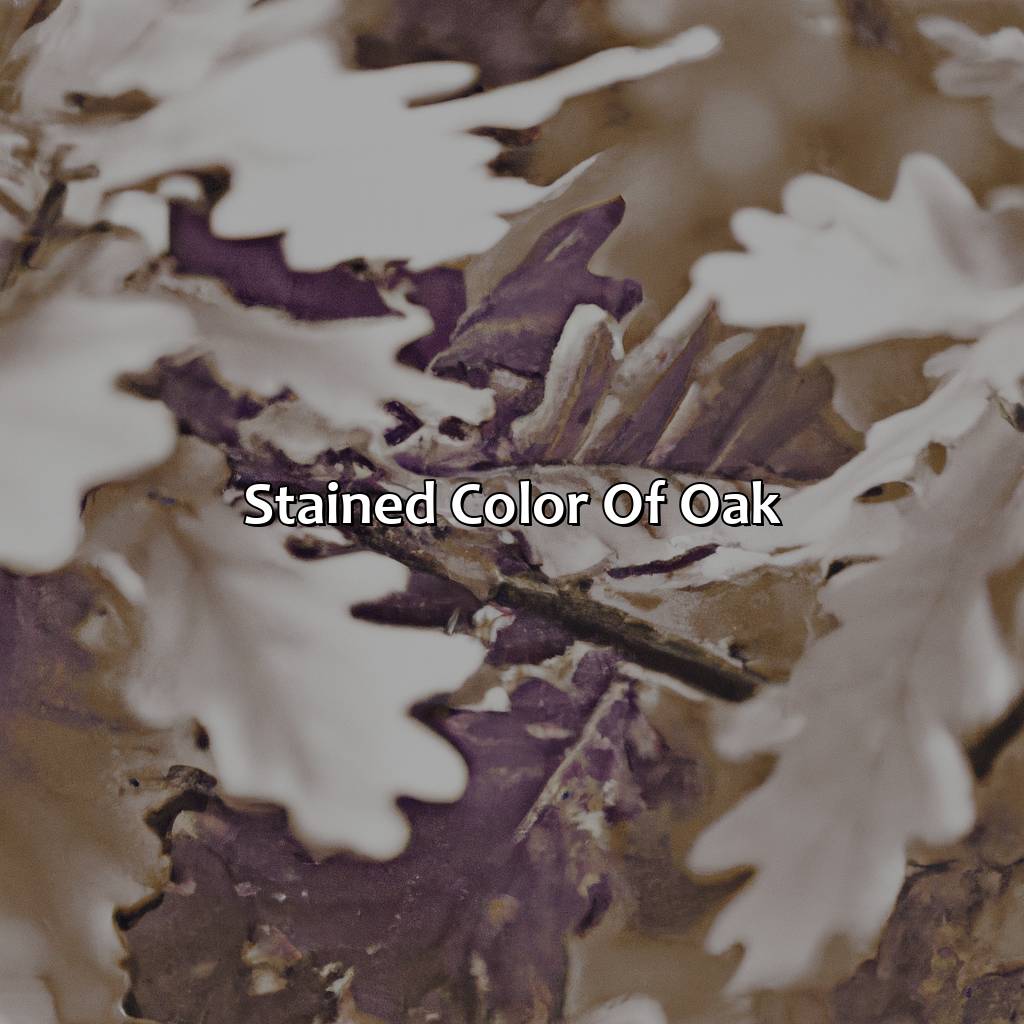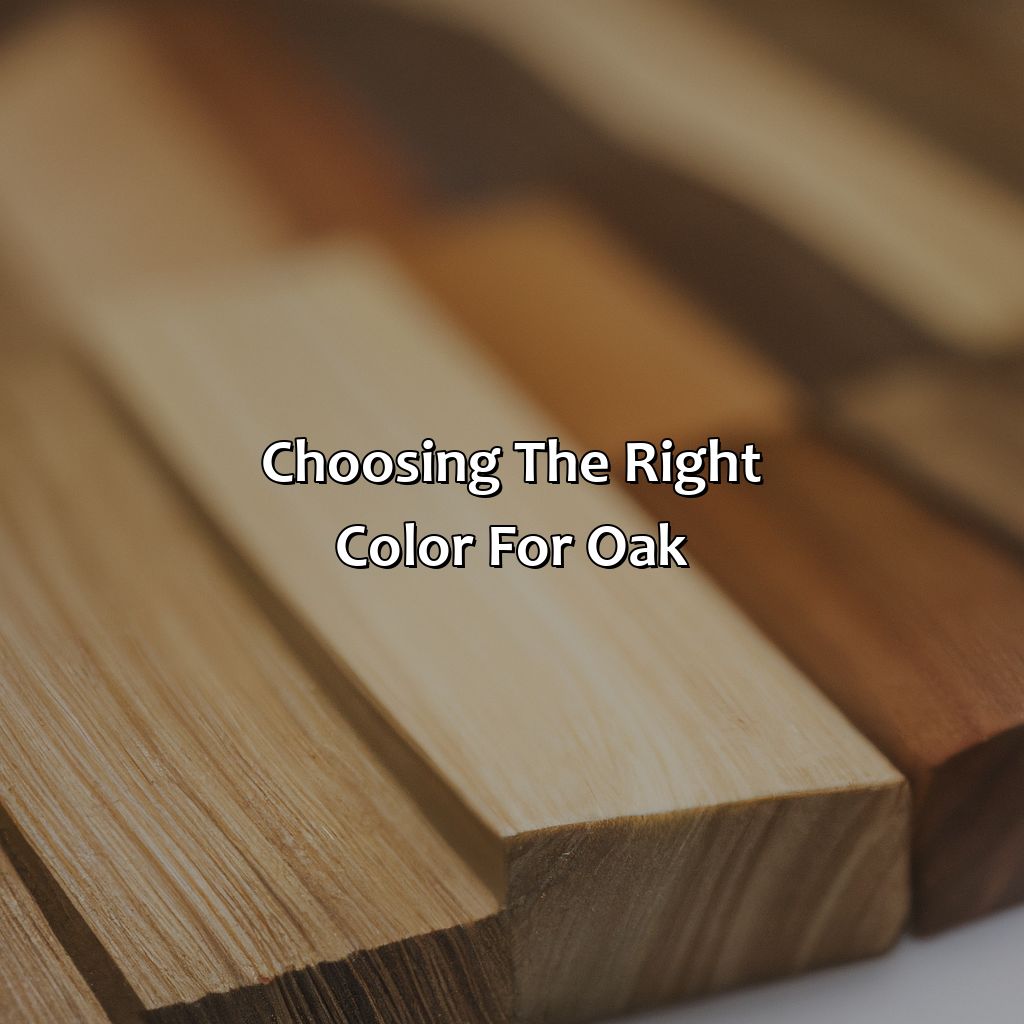Key Takeaway:
- Oak is a type of hardwood tree species that comes in various types, such as white, red, black, and English oak. Oak wood is known for its durability and strength.
- The natural color of oak is a light to medium brown tone, which can vary depending on factors such as age, weather, and environment. Understanding the natural color of oak is important in choosing the right stain for any project.
- Stained color of oak can be achieved through a staining process. Types of stains include water-based, oil-based, and gel-based, and can produce various colors and finishes. When choosing the right color for oak, factors such as lighting, room design, and mood should be taken into consideration.
Overview of Oak
Gaining a better understanding of oaks? This section has it all! Let us introduce you to the definition and features of oaks. We’ll also tell you about the types of oaks and woods available. These include: white oak, red oak, black oak, and English oak. Solution in sight!
Definition of Oak
The characteristics of Oak include its robust texture, durable nature and natural resistance to decay. With a straight grain pattern and a range of tan to light brown color variations, Oak is a popular choice for flooring, furniture, and cabinetry. This versatile hardwood species is adaptable to different environments and can withstand prolonged use without deteriorating rapidly. Its reliability makes it an attractive option for those looking for long-term durability.
When compared to other hardwood species like Cherry or Maple, the definition of Oak stands out with its distinct characteristics that make it a popular choice among homeowners and interior designers alike. The richness of the wood grain lends itself well to both modern and traditional designs alike. Unlike softer woods such as Pine or Poplar, oak resists scratches and dents over time.
What sets oak apart is its ability to take on a range of stains seamlessly making it an ideal material for various design projects. With proper sanding techniques coupled with finishes like oil-based products can enhance its natural beauty further.
There are many stories attached to oak wood, particularly in European cultures where it was often associated with royalty as far back as the medieval era. The majestic trees that produce this hardwood were seen as symbols of strength and endurance, making them an ideal choice for building fortresses and castles centuries ago. Today they continue to hold this reputation globally due their inherent properties making them suitable for varied applications across homes worldwide.
Looking for variety in your oaks? Choose from white, red, black, English – there’s a shade of oak for all your needs.
Types of Oak
Oak wood can be classified into different types based on their distinct characteristics. These types include the highly popular white oak, red oak, black oak, and English oak. Each of these variants exhibits unique characteristics and features that distinguish them from one another.
| Types | Description |
| White Oak | A light-colored wood with a straight grain pattern and a high resistance to moisture and decay. |
| Red Oak | A reddish-brown colored wood with a prominent grain pattern and excellent strength characteristics. |
| Black Oak | A dark-colored hardwood with a strong and durable nature. It is popular for furniture-making and flooring due to its resistance and unique appearance. |
| English Oak | An extremely strong, durable, and popular wood native primarily in Europe used mainly in indoor furniture. |
Apart from the four types mentioned above, other sub-species are found under each type that possesses unique attributes such as texture, tone or sheen. Incorporating any of these types of oak adds an elegant feel to any interior setting.
Pro Tip: Natural staining materials tend to work best for achieving optimal effects on oak coloring; however, it is always advisable to experiment before finalizing the color scheme.
Get ready to fall in love with the natural beauty of oak’s true colors, straight from the tree to your home.
Natural Color of Oak

Photo Credits: colorscombo.com by Arthur Miller
To understand the natural color of oak trees, take a deep dive into understanding its features and properties. Also, look into factors that may change the color. These could include environmental and weather changes, aging, etc.
Understanding the Natural Color of Oak
Oak, a type of hardwood that is widely used in furniture and flooring industry, has a distinctive natural color that varies from light yellow to a darker brown hue. Understanding the natural color of oak requires an in-depth insight into the features and properties of this wood.
The color is generally determined by factors such as the species of oak, age of the tree, and exposure to sunlight. Additionally, different parts of the oak tree have varying colors; sapwood is lighter than heartwood. Overall, understanding these features leads to better comprehension of the unique aspects of natural color in Oak.
Furthermore, age plays a significant role in determining the natural color of oak. Younger trees tend to have lighter colors whereas older trees often develop richer hues due to exposure to sunlight over time. Moreover, specific species may have slightly varied colors depending on their geographical location and other environmental factors such as soil pH levels. It is essential to note that any treatment given during processing can also alter the natural characteristics and appearance of oak.
According to research conducted by Purdue University Cooperative Extension Service, Red Oak tends to take stains more evenly compared with White Oak due to its coarse grain structure leading it not accept dark stains while White Oak accepts them more easily due its smoother grain pattern. What’s interesting about this finding is knowing which lumber would be best suitable for your project or furnishings can save you time and money compared with experimenting with stains.
Even oak can’t escape the ravages of time, weather, and environment when it comes to its natural color.
Factors Affecting the Natural Color of Oak
Oak’s natural color is influenced by different factors, both environmental and non-environmental. These factors can alter the appearance of oak wood in different ways, and it is crucial to understand them for proper maintenance and coloring.
The following table shows the factors affecting the natural color of oak:
| Factors affecting the Natural Color of Oak |
|---|
| Environment |
| Age |
| Weather |
Factors such as the environment in which the tree is grown or stored, its age at harvesting, and exposure to sunlight or moisture are integral in influencing the natural hue of oak. Environmental factors like soil composition, humidity, and temperature contribute significantly to the color variations observed in oak wood. As time passes, changes occur due to aging, which can deepen or lighten the color of oak wood. Weather conditions also play a role in determining oak’s natural color.
Interestingly, other parameters like staining techniques are utilized to change oak’s official color for aesthetic purposes without interfering with its overall structure. According to Food52 Home: “White Oak floors tend to grow darker over time.” Staining oak is an effective way to make its natural beauty even more questionable.
Stained Color of Oak

Photo Credits: colorscombo.com by Joseph Gonzalez
Enhance the stained color of oak wood? Yes! Use a variety of oak wood stain types.
Learn the staining process. This will help you pick the right oak wood stain for your projects. Here’s the scoop: understand the benefits of staining. Also, discover the different types and colors of oak stains.
Understanding the Staining Process
Staining Oak: Features and Application
The process of staining oak involves applying a colorant to alter the natural color of the wood. This technique is commonly used in interior design to achieve a particular aesthetic or complement existing decor. Staining can be done on raw or sanded wood, and it effectively penetrates the pores of the oak, resulting in permanent color changes.
To choose the right stain for your oak project, consider factors such as the desired shade, level of opacity, application method, and drying time. Water-based stains are popular for their eco-friendliness and minimal odor, while oil-based stains offer deeper penetration and a longer working time.
One unique feature of stained oak is that it can highlight some of its natural characteristics. For instance, when choosing a light stain, you can see elements such as knots and grain more clearly than with unpainted wood.
If you’re bored of natural oak, why not add some flair with a colorful stain?
Types of Stains for Oak
When it comes to adding color to oak woodworking or furniture, there are several options available. Different types of stains can be used to achieve the desired shade and tone.
Here is an overview of the types of stains for oak in a tabular format:
| Type of Stain | Description |
|---|---|
| Oil-Based Stain | Absorbs into the wood, dries slowly |
| Water-Based Stain | Dries quickly, eco-friendly |
| Gel Stain | Thicker consistency, easy to apply |
| Varnish Stain | Glossy finish, durable |
It’s important to note that each type of stain has unique properties and may require different application techniques and tools.
In addition to the above types, there are endless color options available for staining oak. The choice depends on personal preference and the intended use of the finished product. Popular colors include light neutrals like natural oak and honey oak, as well as darker shades like chestnut and walnut.
As staining can be a complicated process, it’s best left to professionals if you’re unsure about your skills. They will ensure proper preparation of surfaces before applying stains. It is suggested not mixing different types or colors of stains that cause undesirable results.
It’s recommended that precautionary measures should be taken during maintenance processes such as regular cleaning with soft cloth or dry mop etc.
A true fact- According to Furniture Industry Research Association (FIRA), Oak remains one of the most popular woods for use in furniture manufacturing.
Choosing the right oak color is like choosing the right partner – it needs to complement your style and stand the test of time.
Choosing the Right Color for Oak

Photo Credits: colorscombo.com by Zachary Martinez
Wish to pick the ideal color for your oak decor? Consider factors like room design, mood, and lighting. Here, we give you our section, “Choosing the Right Color for Oak.” It has two sub-sections. They are:
- “Factors to Consider When Choosing Oak Color”
- “Popular Oak Colors in Interior Design”
Factors to Consider When Choosing Oak Color
Choosing the Perfect Oak Color
When considering the ideal color for oak, there are several aspects that must be taken into account:
- Room design: The tone of your oak should be in sync with other elements in the room, such as walls and furniture.
- Lighting: Lighting has a substantial impact on color perception. Understand how lighting conditions in your room could alter the appearance of your oak.
- Factors: The grade and construction of oak will affect its look. Choose an oak product that fits your tastes or style.
- Mood: Different colors can evoke different moods. Consider what sort of mood you desire to establish in your area, and choose a color that fits it appropriately.
- Durability: While color is essential, don’t forget about durability. Ensure whatever finish or stain you choose is long-lasting enough for years to come.
Additionally, as each space has its unique attributes, it’s crucial not to overlook the little details when selecting an oak product.
When choosing an appropriate shade for your oak’s flooring or furniture piece, keep in mind that factors such as existing tones on floors or walls also significantly impact the final product. Therefore, it is best to ask for a specialist opinion before settling down with one.
In addition, it is vital to remember that certain hues and finishes necessitate additional maintenance than others. Choose a stain or hue that suits viable upkeep habits so that their natural glow can last much beyond daylight hours.
By keeping these points in consideration while picking out the color of oak, one can achieve a look that seamlessly complements their room design while also satisfying all their practical requirements concurrently.
Popular Oak Colors: Because if you’re going to have wood paneling in your home, might as well go with a timeless classic.
Popular Oak Colors in Interior Design
Popular Oak Color Schemes in Interior Design are sought after by many homeowners and interior designers. These colors bring warmth, elegance, and rustic charm to any space. To achieve these effects while designing with oak, here are some popular color schemes that can be used:
- Earthy Tones – Shades of beige, brown, and cream blend well with natural oak grains. This combination adds a cozy ambiance and accentuates the wood’s warm tones.
- Muted Colors – Muted shades of blue or green complement the natural oak color palette while providing a calming effect. These soft hues create an inviting atmosphere suitable for bedrooms or family rooms.
- Dark Contrasts – Rich charcoal gray walls set off the honey-golden tones and enhance the dramatic visuals of oak wood grain. High contrast such as navy blue is another bold choice that complements natural oak finishes.
- White Walls – The fresh look is always in with white walls serving as a classic backdrop for the subtle hues of unique oak finishes. White walls allow tannins, knots, grains and motifs on the oak surfaces to pop-out more distinctly.
One important consideration when choosing popular Oak Color Schemes in Interior Design is to understand how light affects color perception in spaces. Additionally, one must consider other factors like existing furniture pieces or overall room style.
Pro Tip: Experimenting with different Oak Color Schemes can be an exciting way to transform any living space into a cozy sanctuary deserving of guests’ praises!
Maintaining Oak Color: Because even the most majestic tree needs a little upkeep to stay vibrant.
Maintaining Oak Color

Photo Credits: colorscombo.com by Anthony Flores
Want to keep your oak looking its best? Follow these tips! Cleaning, polishing, protection, and refinishing are all necessary for maintaining its natural or stained color. Check the two sub-sections below for tips that will work with your oak’s color.
Keep your oak furniture and flooring in top condition!
Tips for Maintaining the Natural Color of Oak
Maintaining Oak’s Natural Rich Color
Preserve the natural beauty of oak with these professional tips.
- Polish your oak surface to enhance its shine and protect it from scratches. Use a microfiber cloth and a commercial wood polish, following the product’s instructions.
- Clean up any spills immediately to avoid moisture seeping into the surface. A dry cloth or paper towel is enough for most spills, but use a slightly damp cloth for tougher stains.
- Avoid placing hot pots and pans, or dishes straight out of the oven, directly on the oak surface; use trivets instead.
- Keep away from direct sunlight that causes discoloration over time. Use window treatments and rearrange furniture to maintain an even exposure to natural light.
- Rotate decor pieces over oak surfaces to prevent fading due to repeated exposure. Placemats and coasters can provide additional protection while decorating your space.
- Follow through with manufacturer-recommended resealing process in every few years or based on the level of usage. Wood conditioner can also replenish oils that are lost with wear over time.
It is essential to remember that taking excellent care of an oak item involves adequate cleaning using soft cloths and gentle products. Avoid abrasive cleaners that alter the wood’s natural color or texture – this goes without saying.
Pro Tip: Incorporate felt pads on table legs for easier moving around, reducing stress on delicate surfaces and protecting against scratches. These tips will ensure your natural-looking Oak projects stay ruggedly robust!
Make sure your stained oak stays spotless with these easy tips for cleaning and refinishing.
Tips for Maintaining the Stained Color of Oak
To maintain the stained color of oak, it is essential to follow proper tips for cleaning and refinishing. Regular maintenance of oak furniture ensures its longevity and aesthetic appeal.
- Protect from Direct Sunlight: The first tip for maintaining the stained color of oak furniture is to protect it from direct sunlight. Exposure to UV light can cause fading of color, leading to discoloration or yellowing.
- Use Appropriate Cleaning Materials: Use a mild soap solution or a specialized wood cleaner and a soft cloth to clean the surface gently. Avoid harsh chemical cleaners that can damage the finish and lead to color loss.
- Regular Dusting: Dust your oak furniture with a microfiber cloth regularly. This action helps avoid dirt buildup, which can lead to scratches or stains on the surface.
- Avoid Extreme Temperature and Humidity: High humidity levels can cause the wood to swell, while low humidity leads to drying out and cracking. Always maintain stable temperature and moisture level in your home.
- Refinishing when Necessary: If there are scratches or stains on the oak furniture that cannot be removed through regular cleaning, consider refinishing it entirely or spot treating if necessary.
It is fundamental also to ensure you do not place hot objects directly on top of your oak furniture as this may develop unsightly scorch marks.
Pro Tip: Instead of using traditional oils, beeswax makes an ideal natural polish for enhancing glossiness and protection of Oak furniture.
Five Facts About the Color Oak:
- ✅ Oak can come in various colors, ranging from light beige to rich reddish-brown. (Source: The Spruce)
- ✅ The color of oak can vary due to factors such as the species of oak, the age of the wood, and the way it was treated. (Source: Wood Finishes Direct)
- ✅ The color of oak may change or darken over time due to exposure to light and air. (Source: Woodcraft)
- ✅ Oak is a popular choice for flooring, furniture, and cabinetry due to its durability and versatility in color and texture. (Source: Flooring America)
- ✅ The color of oak may be influenced by the way it was cut, with quarter-sawn oak having a distinct grain pattern and color variation. (Source: Woodworkers Source)
FAQs about What Color Is Oak
What color is oak?
Oak can vary in color depending on the species and location it was grown, but generally ranges from light tan to medium or dark brown. Some oaks may also have yellow or reddish tones.
Can oak be painted or stained a different color?
Yes, oak can be painted or stained a different color to match your desired aesthetic. However, it is important to properly prep the oak surface before applying any paint or stain.
Does the color of oak affect its durability?
No, the color of oak does not affect its durability. Other factors such as age, grain pattern, and moisture levels can impact the strength and longevity of oak.
Is the color of oak affected by sunlight or aging?
Yes, oak can be affected by sunlight and aging. Exposure to sunlight can cause oak to become slightly lighter in color over time, while aging can cause the wood to darken and develop a richer patina.
Are there any other variations of oak besides color?
Yes, there are many variations of oak beyond color. Some of the most important variations include species, grain pattern, and hardness. These factors can impact how oak is used and what applications it is best suited for.
What are some popular ways to incorporate the color of oak into home decor?
Oak can be incorporated into home decor in many ways, such as through flooring, furniture, cabinetry, and trim work. Some popular design styles that feature oak include traditional, rustic, and farmhouse.






